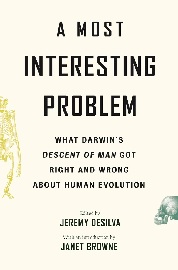A Most Interesting Problem: What Darwin’s Descent of Man got Right and Wrong About Human Evolution

Jeremy Desilva (Ed.)
Princeton University Press, £22.00
Have a really good idea, then recruit some excellent science communicators to implement it and you have a great chance of producing a book with widespread appeal. That formula seems to work very well for this book.
Following the editor’s preface, which discusses Darwin’s intriguing encounter with the fossil skull found in Gibraltar in 1848 and an introduction by Janet Browne to Darwin’s key works, nine analytical chapters form the core of the book. The concluding chapter compares Darwin’s views with what we have discovered in the remarkable 150 years of research since 1871. This final chapter by Ann Gibbons is delightfully titled “Dinner with Darwin: Sharing the Evidence Bearing on the Origins of Humans.”
It starts with a recollection of a group visit to Down House then evolves into an imagined conversation around the dining room table there and what scientists of today would want to say to Darwin about his book in the light of modern research.
The analytical chapters range across the life and social sciences with consideration, for example, of the evolution of the human brain through to Darwin’s views on race and his difficult struggle to distance himself from the social and cultural views of his class and time – and the pernicious continuing impact of such views today. But what comes though time and again is how right Darwin was about so much of the science. Given that I had just read Meave Leakey’s The Sediments of Time, I really enjoyed how Yohannes Haile-Selassie illustrated this point in the chapter on the fossil evidence for human evolution.
As the chapter concludes, the evidence we have demonstrates that Darwin was correct in believing that “the birthplace of the human lineage is in Africa.” However, he was wrong in thinking that becoming bipedal coincided with the use of tools and that this was then followed by canine tooth reduction and brain enlargement. We now know that bipedalism came first well before tool use, but the reason why is still not understood - which demonstrates, as do the other chapters, how much more work needs to be done on this most interesting problem.
Malcolm Dando FRSB


